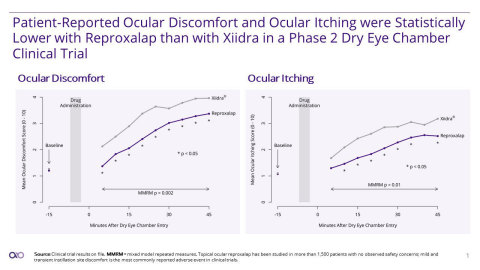Aldeyra Therapeutics Announces Positive Top-Line Data from Phase 2 Dry Eye Chamber Clinical Trial of Reproxalap, an Investigational New Drug, Compared to Xiidra®
- Reproxalap Statistically Lower than Xiidra for the Two Endpoints of the Trial: Ocular Discomfort (p=0.002) and Ocular Itching (p=0.01)
- Results Consistent with Data from Post-Acute Ocular Tolerability Comparison of Reproxalap and Xiidra in Patients with Dry Eye Disease

“The statistically significant symptom improvement of reproxalap over Xiidra observed in this trial reinforces the data from an earlier clinical trial demonstrating tolerability advantages of reproxalap over Xiidra in patients with dry eye disease,”1 stated
“The clinically relevant and statistically significant reduction in symptomatic activity suggest that reproxalap, if approved, has the potential to become a first-line therapy for the treatment of dry eye disease,” stated
The double-masked, crossover, single-center, Phase 2 clinical trial in 56 dry eye disease patients evaluated the activity of reproxalap compared to Xiidra for two endpoints: ocular discomfort symptom score and ocular itching symptom score. A single dose of test article was administered to both eyes approximately 5 minutes prior to a dry eye chamber exposure lasting 45 minutes, during which humidity was maintained at low levels in a setting of regulated air flow, temperature, and visual tasking. Symptoms were assessed approximately 15 minutes prior to chamber entry, and every 5 minutes beginning 5 minutes after chamber entry.
No safety signals were observed in the trial, and there were no treatment-related discontinuations or moderate or serious adverse events related to drug. The most common adverse event in both treatment arms was mild instillation site discomfort. Reproxalap has now been evaluated in more than 1,500 patients. The approved commercial dosing regimen of Xiidra and the intended commercial dosing regimen of reproxalap include repeated administration of drug.
Aldeyra plans to present data from the trial at an upcoming medical meeting.
About Reproxalap
Reproxalap, an investigational new drug, is a novel small-molecule modulator of RASP (reactive aldehyde species), which are elevated in ocular and systemic inflammatory disease. Reproxalap’s mechanism of action has been supported by the demonstration of statistically significant and clinically relevant activity in multiple physiologically distinct late-phase clinical indications. Reproxalap is currently in Phase 3 clinical development as a
About Dry Eye Disease
Dry eye disease is a common inflammatory disease estimated to affect 34 million or more adults in
About
Safe Harbor Statement
This release contains forward-looking statements within the meaning of the Private Securities Litigation Reform Act of 1995, including, but not limited to, statements regarding Aldeyra's strategy, future operations, prospects, plans, and objectives and Aldeyra's plans and expectations for its product candidates, including reproxalap. Aldeyra intends such forward-looking statements to be covered by the safe harbor provisions for forward-looking statements contained in Section 21E of the Securities Exchange Act of 1934 and the Private Securities Litigation Reform Act of 1995. In some cases, you can identify forward-looking statements by terms such as, but not limited to, "may," "might," "will," "objective," "intend," "should," "could," "can," "would," "expect," "believe," "anticipate," "project," "on track," "scheduled," "target," "design," "estimate," "predict," "potential," "aim," "plan" or the negative of these terms, and similar expressions intended to identify forward-looking statements. Such forward-looking statements are based upon current expectations that involve risks, changes in circumstances, assumptions, and uncertainties. Aldeyra is at an early stage of development and may not ever have any products that generate significant revenue. All of Aldeyra's development timelines may be subject to adjustment depending on recruitment rate, regulatory review, preclinical and clinical results, and other factors that could delay the initiation or completion of clinical trials. Important factors that could cause actual results to differ materially from those reflected in Aldeyra's forward-looking statements include, among others, the timing of enrollment, commencement and completion of Aldeyra's clinical trials; the timing and success of preclinical studies and clinical trials conducted by Aldeyra and its development partners; updated or refined data based on Aldeyra's continuing review and quality control analysis of clinical data, Aldeyra's ability to design clinical trials with protocols and endpoints acceptable to applicable regulatory authorities; delay in or failure to obtain regulatory approval of Aldeyra's product candidates; the ability to maintain regulatory approval of Aldeyra's product candidates, and the labeling for any approved products; the risk that prior results, such as signals of safety, activity or durability of effect, observed from preclinical or clinical trials, will not be replicated or will not continue in ongoing or future studies or clinical trials involving Aldeyra's product candidates in clinical trials focused on the same or on different indications; the risk that the results from earlier clinical trials, portions of clinical trials, or pooled clinical data may not accurately predict results of subsequent trials or the remainder of a clinical trial; the risk that results from comparative clinical trials, such as ocular discomfort and itching comparisons, may not be replicated with repeated administration of drug as directed by the intended commercial dosing regimen and the commercial dosing regimen, as applicable; the scope, progress, expansion, and costs of developing and commercializing Aldeyra's product candidates; uncertainty as to Aldeyra’s ability to commercialize (alone or with others) Aldeyra's product candidates following regulatory approval, if any; the size and growth of the potential markets and pricing for Aldeyra's product candidates and the ability to serve those markets; Aldeyra's expectations regarding Aldeyra's expenses and revenue, the sufficiency or use of Aldeyra's cash resources and needs for additional financing; political, economic, legal, social and health risks, including the COVID-19 pandemic and related public health measures, that may affect Aldeyra’s business or the global economy; the rate and degree of market acceptance of any of Aldeyra's product candidates; Aldeyra's expectations regarding competition; Aldeyra's anticipated growth strategies; Aldeyra's ability to attract or retain key personnel; Aldeyra’s limited sales and marketing infrastructure; Aldeyra's ability to establish and maintain development partnerships; Aldeyra’s ability to successfully integrate acquisitions into its business; Aldeyra's expectations regarding federal, state and foreign regulatory requirements; regulatory developments in
In addition to the risks described above and in Aldeyra's other filings with the
1 McMullin D, Clark D, Cavanagh B, Karpecki P, Brady TC. A Post-Acute Ocular Tolerability Comparison of Topical Reproxalap
2 White DE, Zhao Y, Ogundele A, Fulcher N, Acs A,
3 Paulsen AJ, Cruickshanks KJ, Fischer ME, Huang GH, Klein BE, Klein R, Dalton DS. Dry eye in the beaver dam offspring study: prevalence, risk factors, and health-related quality of life. Am J Ophthalmol. 2014 Apr;157(4):799-806. doi: 10.1016/j.ajo.2013.12.023. Epub 2014
4 Choi W, Lian C, Ying L, Kim GE, You IC, Park SH, Yoon KC. Expression of Lipid Peroxidation Markers in the Tear Film and Ocular Surface of Patients with Non-Sjogren Syndrome: Potential Biomarkers for Dry Eye Disease. Curr
View source version on businesswire.com: https://www.businesswire.com/news/home/20220110006109/en/
Corporate:
Tel: 781-761-4904 ext. 218
jreed@aldeyra.com
Investors & Media:
Tel: 617-542-5300
ALDX@investorrelations.com
Source:







